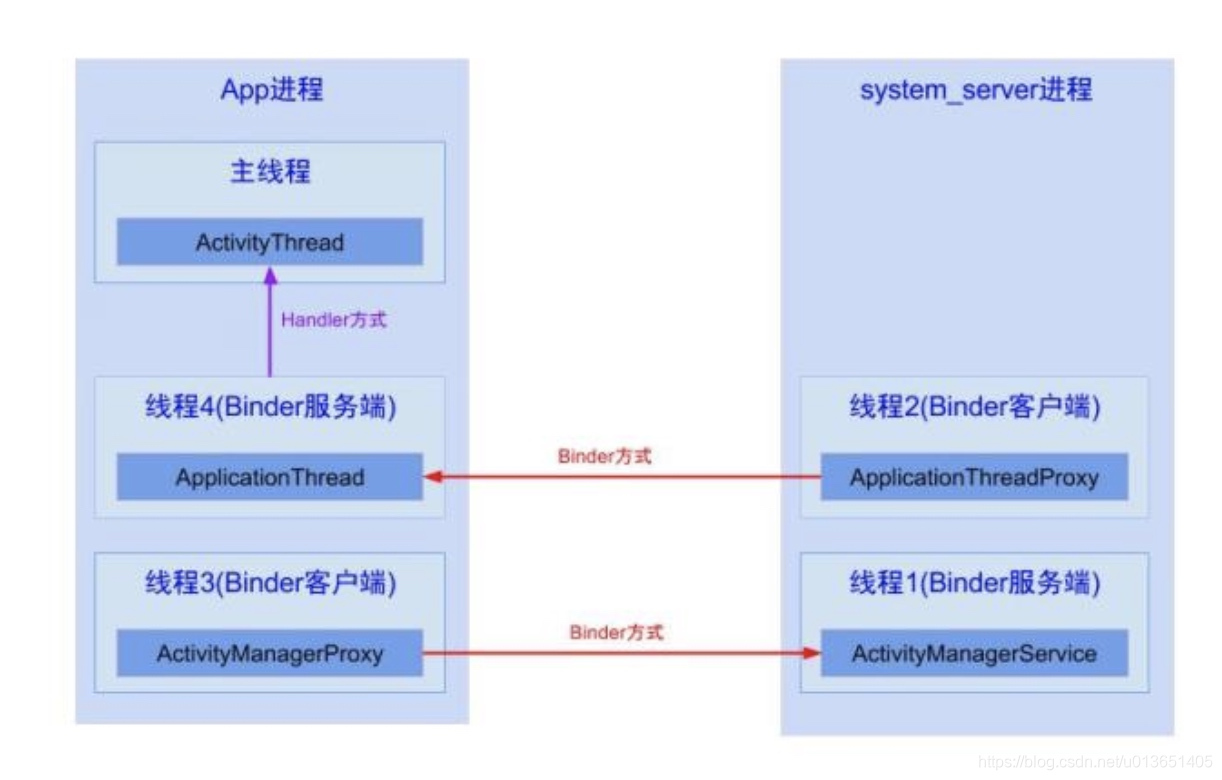概述
Android 的消息机制主要指的是 Handler 的运行机制,Handler 的运行需要底层的 MessageQueue 和 Looper 的支撑,而传输的对象是 Message。
关系图


名词解析
Message:消息,其中包含了消息ID、消息处理对象以及处理的数据等,由MessageQueue统一列队,最后还是有Handler处理。
Handler:处理者,负责Message的发送及处理,使用Handler时,需实现handleMessage(Message msg)方法来对特定的Message进行处理,比如更新UI,更新数据库。
MessageQueue:消息队列,用来存放Handler发送过来的消息,并按照FIFO规则执行。当然,存放Message并非实际意义的保存,而是将Message以链表的方式串联起来,等待Looer的抽取。
Looper:消息泵/轮询器,Looper用于封装了android线程中的消息循环,默认情况下一个线程是不存在消息循环(message loop)的,需要调用Looper.prepare()来给线程创建一个消息循环队列,每个线程只允许一次,调用Looper.loop()来使消息循环起作用,在ActivityThread中会执行 Looper.prepare()和Looper.loop()方法。使用Looper.prepare()和Looper.loop()创建了消息队列就可以让消息处理在该线程中完成。一直地从MessageQueue中抽取Message执行,如果匹配不到处于阻塞状态。因此,一个MessageQueue需要一个Looper。
ThreadLocal:它并非线程,而是在线程中存储数据用的。
Thread:线程,负责调度整个消息循环,即消息循环的执行场所。
Message
Message 是一个继承 Parcelable 的持久化类,通过内部构建一个链表来维护一个被回收的 Message 对象的对象池,当用户调用 obtain() 的时候,会优先从池中取。如果没有会重现创建一个
public static Message obtain() {
synchronized (sPoolSync) {
if (sPool != null) {
Message m = sPool;
sPool = m.next;
m.next = null;
m.flags = 0; // clear in-use flag
sPoolSize--;
return m;
}
}
return new Message();
}
通过这个方法,我们可以知道在在获取 Message 对象的时候并不是每次都创建一个,而是获取 Message 的链表头,存储形式是单链表,且此处加入了同步锁保证数据不被污染。
链表中的数据添加是在 Message 要被回收的时候,当要被回收时,会把使用过后的 Message 添加到链表中
public void recycle() {
if (isInUse()) {
if (gCheckRecycle) {
throw new IllegalStateException("This message cannot be recycled because it "
+ "is still in use.");
}
return;
}
recycleUnchecked();
}
/**
* Recycles a Message that may be in-use.
* Used internally by the MessageQueue and Looper when disposing of queued Messages.
*/
void recycleUnchecked() {
// Mark the message as in use while it remains in the recycled object pool.
// Clear out all other details.
flags = FLAG_IN_USE;
what = 0;
arg1 = 0;
arg2 = 0;
obj = null;
replyTo = null;
sendingUid = -1;
when = 0;
target = null;
callback = null;
data = null;
synchronized (sPoolSync) {
if (sPoolSize < MAX_POOL_SIZE) {
next = sPool;
sPool = this;
sPoolSize++;
}
}
}
这个对象池的大小默认为 50 个,如果小于50个,则把数据插入到链表的尾部
MessageQueue
消息队列,内部本质是一个单链表的数据结构。插入使用的enqueueMessage和next方法的实现。从源码中我们可以得到,无论插入还是删除均是在无线循环的,一直在监听此单链表的变化.
插入:enqueueMessage(Message msg,long when)
刁调用入口是在 handler.sendMessageAtTime 中。
读取:next()
调用入口是在 looper 的死循环中,核心方法为nativePollOnce方法,此方法调用底层它查看当前消息是否有消息,如果有消息则获取,如果没有就等待。
Looper
轮询器, 扮演着消息轮训的作用.不停的查看 MessageQueue 中是否有消息.常见的 Looper.prepare 方法做了如下事情
private static void prepare(boolean quitAllowed) {
if (sThreadLocal.get() != null) {
throw new RuntimeException("Only one Looper may be created per thread");
}
sThreadLocal.set(new Looper(quitAllowed));
}
new 了一个 looper, 并且被本地缓存 sThreadLocal 持有。
private Looper(boolean quitAllowed) {
mQueue = new MessageQueue(quitAllowed);
mThread = Thread.currentThread();
}
创建Looper 的时候会创建一个此 Looper 的对应的 MessageQueue.
Looper 最关键的是 loop 方法,只有调用了此方法后,消息循环系统才会真正开始工作。
public static void loop() {
final Looper me = myLooper();
if (me == null) {
throw new RuntimeException("No Looper; Looper.prepare() wasn't called on this thread.");
}
final MessageQueue queue = me.mQueue;
// Make sure the identity of this thread is that of the local process,
// and keep track of what that identity token actually is.
Binder.clearCallingIdentity();
final long ident = Binder.clearCallingIdentity();
for (;;) {
Message msg = queue.next(); // might block
if (msg == null) {
// No message indicates that the message queue is quitting.
return;
}
try {
msg.target.dispatchMessage(msg);
} finally {
if (traceTag != 0) {
Trace.traceEnd(traceTag);
}
}
// Make sure that during the course of dispatching the
// identity of the thread wasn't corrupted.
final long newIdent = Binder.clearCallingIdentity();
if (ident != newIdent) {
Log.wtf(TAG, "Thread identity changed from 0x"
+ Long.toHexString(ident) + " to 0x"
+ Long.toHexString(newIdent) + " while dispatching to "
+ msg.target.getClass().getName() + " "
+ msg.callback + " what=" + msg.what);
}
msg.recycleUnchecked();
}
}
looper 方法里面本质是一个死循环,跳出循环的终止条件是 MessageQueue 中next 方法返回为 null。loop 方法会调用 messageQueue 的 next 方法,而 next 方法是一个阻塞的方法,当没有消息时,next 一直阻塞,导致 looper 也阻塞在这边。如果 next 有返回值,则会执行 msg.target.dispatchMessage(msg),这里的 msg.target 指的就是当前的 handler,这样消息就成功的交给了 Handler 的 dispatchMessage 来处理。
ThreadLocal
帮助 handler 获得当前线程的 Looper,不同线程访问同一个 ThreadLocal 的 get 方法,ThreadLocal 内部会从各自的线程中取出一个数组,然后再从数组中根据当前ThreadLocal 的索引去查找出对应的 valu e值。也就说不同的 Looper 是相互独立的,主要看下 set / get 方法。
先看 set,value即要存储的数据。ThreadLocalMap 是ThreadLocal中的一个内部类,主要用来存储threadLocal中的数据,下面会详细说明。通过上面这段代码,我们可以知道,set方法首先会获取当前线程的ThreadLocalMap。如果map不为空,则直接更新数据;否则,创建ThreadLocalMap,同时将value值放入该map中,ThreadLocalMap是ThreadLocal中的一个静态内部类
//Sets the current thread's copy of this thread-local variable
* to the specified value.
public void set(T value) {
Thread t = Thread.currentThread();
ThreadLocalMap map = getMap(t);
if (map != null)
map.set(this, value);
else
createMap(t, value);
}
通过源码我们可以知道,get方法也是先要获取ThreadLocalMap ,若ThreadLocalMap 不为空,则获取其内部的Entry
// Returns the value in the current thread's copy of this thread-local variable.
public T get() {
Thread t = Thread.currentThread();
ThreadLocalMap map = getMap(t);
if (map != null) {
ThreadLocalMap.Entry e = map.getEntry(this);
if (e != null) {
@SuppressWarnings("unchecked")
T result = (T)e.value;
return result;
}
}
return setInitialValue();
}
由上面对ThreadLocal的set和get方法的分析,我们可以看出,我们操作的始终是当前线程的ThreadLocalMap,存放的数据在Entry中,table中又存放了大量的Entry,对Entry进行管理,而table数组又在当前线程的ThreadLocalMap,所以我们在不同线程中访问同一个ThreadLocal的set和get方法时,它们对ThreadLocal的读/写操作都仅仅是在各自线程的内部而已。这就解释了为什么ThreadLocal可以在多个线程中互不干扰地存储和修改数据了。
经典问题
【问题】Android中为什么主线程不会因为Looper.loop()里的死循环卡死?
对于线程既然是一段可执行的代码,当可执行代码执行完成后,线程生命周期便该终止了,线程退出。而对于主线程,我们是绝不希望会被运行一段时间,自己就退出,那么如何保证能一直存活呢?简单做法就是可执行代码是能一直执行下去的,死循环便能保证不会被退出.
【问题】主线程的死循环一直运行是不是特别消耗CPU资源?
涉及到Linux pipe/epoll机制,简单说就是在主线程的MessageQueue没有消息时,便阻塞在loop的queue.next()中的nativePollOnce()方法里.此时主线程会释放CPU资源进入休眠状态,直到下个消息到达或者有事务发生,通过往pipe管道写端写入数据来唤醒主线程工作。这里采用的epoll机制,是一种IO多路复用机制,可以同时监控多个描述符,当某个描述符就绪(读或写就绪),则立刻通知相应程序进行读或写操作,本质同步I/O,即读写是阻塞的。 所以说,主线程大多数时候都是处于休眠状态,并不会消耗大量CPU资源。
【问题】结合消息机制,说说Activity onResume的方法的内部流程
ActivityThread的内部类H继承于Handler,通过handler消息机制,简单说Handler机制用于同一个进程的线程间通信。Activity的生命周期都是依靠主线程的Looper.loop,当收到不同Message时则采用相应措施:在H.handleMessage(msg)方法中,根据接收到不同的msg,执行相应的生命周期。
线程1的AMS中调用线程2的ATP;(由于同一个进程的线程间资源共享,可以相互直接调用,但需要注意多线程并发问题)线程2通过binder传输到App进程的线程4;线程4通过handler消息机制,将暂停Activity的消息发送给主线程;主线程在looper.loop()中循环遍历消息,当收到暂停Activity的消息时,便将消息分发给ActivityThread.H.handleMessage()方法,再经过方法的调用,最后便会调用到Activity.onPause(),当onPause()处理完后,继续循环loop下去。





















 611
611











 被折叠的 条评论
为什么被折叠?
被折叠的 条评论
为什么被折叠?








